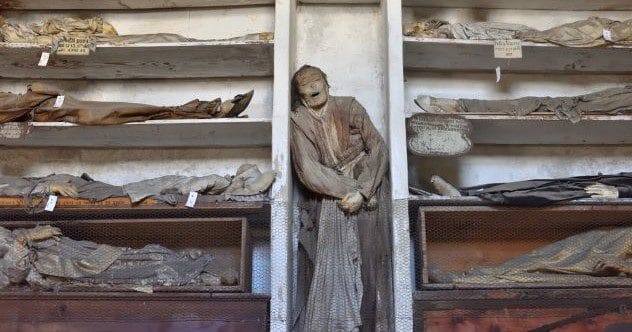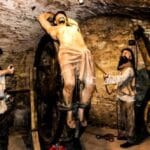Mummies have always captured our imaginations, providing a spooky peek into the lives and deaths of ancient peoples. They’re not just confined to the majestic tombs of Egypt. From the icy peaks of the Andes to the misty catacombs of Italy, mummies have been found in the most unexpected places. Each one has a tale that’s as strange as it is unsettling.
These preserved remains are more than just relics. They’re windows into forgotten worlds where the line between life and death was often blurred. These stories reveal not just the ancient practices surrounding death but also the deep cultural beliefs that still resonate today. So, get ready to journey through time and across continents as we dive into these ten bizarre mummy tales. Each story peels back another layer of mystery and intrigue, reminding us that every mummy has a tale waiting to be told—sometimes, it’s stranger than fiction.
The Lost Children of Palermo’s Catacombs
In Palermo, Sicily, the Capuchin Catacombs hold a moving and eerie secret: the mummified remains of hundreds of children. These tiny bodies, dressed in their best clothes, have been preserved for centuries, their faces frozen in a peaceful rest. But behind their stillness lies a mystery that has haunted historians and locals alike—who were these children, and why were they mummified with such care?
Unlike the grand mummies of Egypt, these little ones seem almost lifelike, as if they could wake up at any moment. Their presence is both haunting and heartbreaking, a stark reminder of the fragility of life in a time long past. Scientists are now using modern technology to try and uncover the stories these children left behind. With DNA analysis and advanced imaging, they hope to finally give names to the nameless and understand the practices that led to their preservation.
As the investigation unfolds, the child mummies of Palermo draw us closer to a past that is both mysterious and sad. These lost children, preserved in time, may soon have their stories told—stories that speak of love, loss, and the desire to remember.
The Haunting Faces of Guanajuato’s Mummies
In Guanajuato, Mexico, there’s a museum that feels like a dark fairy tale. The Museo de las Momias is home to the naturally preserved bodies of dozens of men, women, and children. These mummies weren’t created through ancient rituals; instead, they were victims of circumstances, unearthed when their families couldn’t afford the burial tax. The dry climate and unique conditions in the crypts did the rest, preserving them in a fascinating and unsettling way.
As you walk through the museum, you’re met with the hollow stares of these long-departed souls, their faces twisted in what looks like an eternal scream. The sight is chilling—dried skin pulled tight over fragile bones, hair still clinging to their skulls, and clothing that has stood the test of time. Among the most heart-wrenching are the infants, dressed in tiny gowns, their innocence making the scene even sadder.
This collection is a reminder of a time when death was a spectacle and poverty could mean being exposed forever. The mummies of Guanajuato, once displayed for a few pesos, now draw visitors worldwide, each contemplating the stories behind those haunting faces. It’s an experience that stays with you, a reminder of the delicate line between life and death.
The Mesmerizing Tattoos of the Siberian Ice Maiden
High in the Altai Mountains of Siberia, archaeologists found a stunning relic: the Siberian Ice Maiden. This 2,500-year-old mummy, preserved by the permafrost, has captivated the world because of the detailed tattoos on her skin. Buried with goods and six horses, the Ice Maiden’s resting place hints at her status within the Pazyryk culture, but it’s her tattoos that tell the most interesting story.
The tattoos are mesmerizing. Across her arm is a detailed picture of a deer with grand antlers, surrounded by mythical creatures. These designs are believed to hold spiritual meaning, possibly indicating that the Ice Maiden was a shaman or revered figure. The artistry and symbolism offer a window into a world where body art was a powerful expression of identity and belief.
The Siberian Ice Maiden continues to fascinate. Preserved by ice and time, her tattoos connect us to an ancient culture where every mark on the skin carried significance, bridging the gap between the earthly and the divine.
The Frozen Children of Llullaillaco
In the icy peaks of the Andes, archaeologists uncovered a testament to the Incan world: the frozen bodies of three young children sacrificed over 500 years ago. Known as the “Children of Llullaillaco,” these perfectly preserved mummies were found near the summit of Mount Llullaillaco in Argentina. They are serene and their clothing is intact, offering a glimpse into the past. These children, chosen for their beauty and purity, were part of a sacred ritual called “capacocha,” believed to honor the gods and ensure the empire’s success.
The oldest, a 15-year-old girl now called the “Llullaillaco Maiden,” sits with a calm expression as if caught in eternal sleep. Her headdress, finely braided hair, and woven garments speak of her status and the significance of her sacrifice. Beside her, the two younger children lie in similar states of preservation, their small bodies telling a story of a journey both sacred and sorrowful.
Researchers have been able to piece together the children’s final days—the diets they were given, the substances used to sedate them, and the journey that led them to this mountaintop. The discovery of the Children of Llullaillaco offers a connection to a world where devotion to the gods demanded the ultimate sacrifice, leaving us to ponder the nature of faith and duty in ancient cultures.
The Eerie Frankenstein Mummies of Scotland
On the island of South Uist in Scotland, archaeologists made a discovery straight out of a gothic novel: mummies pieced together from the remains of multiple people. Found at the Cladh Hallan site, these “Frankenstein mummies” were unlike anything seen before. One skeleton was a puzzle, with a torso and limbs from one person, a skull from another, and a lower jaw belonging to a third individual. It was as if these ancient people had created new ancestors by merging the bones of different individuals.
Researchers think this practice was a way to combine different family lines or reinforce claims to land. By uniting the remains of several ancestors into one body, the living could create a symbol of unity and continuity. These bodies were carefully preserved, likely in the acidic peat bogs of the region, which helped keep them intact long enough to be assembled in this way.
This discovery has changed our understanding of mummification, revealing that it wasn’t just an Egyptian practice but also found in ancient Britain, where people had their own ways of connecting with the past.
The Chilling Tale of Venice’s Vampire Grave
In 2006, archaeologists on the Venetian island of Lazzaretto Nuovo unearthed a discovery: the skeleton of a woman with a brick wedged in her mouth. This find, dating back to the 16th century, was made in a mass grave filled with plague victims. At the time, the fear of vampires was widespread, and this woman was likely accused of being one. The brick was placed in her mouth to stop her from rising from the dead and feeding on the living.
During the plague years, people were gripped by terror and superstition. The sight of decomposing bodies fueled the belief that these corpses were “shroud-eaters,” or vampires spreading the disease. By sealing the mouth of a suspected vampire with something inedible, they hoped to prevent it from chewing through its shroud and rising from the grave.
This discovery offers a glimpse into the fears that dominated life during the plague. The “Venetian vampire” is a reminder of how fear and folklore can influence human behavior, especially in the face of loss and uncertainty.
The Haunting Death of Egypt’s Screaming Mummy
In 1935, archaeologists unearthed a mummy at Deir el-Bahari near Luxor that would become known as the “Screaming Mummy.” The woman’s face, frozen in terror, suggested a death filled with agony. Researchers now believe she may have died suddenly from severe pain or a heart attack, causing a phenomenon called cadaveric spasm. This led to her facial muscles contracting violently at the moment of death, preserving her scream.
Unlike many hastily buried mummies, the Screaming Mummy was embalmed with care using costly ingredients like juniper oil and frankincense. She was also adorned with jewelry, including gold and silver rings, indicating her high status. These details suggest that despite her final moments, she was someone of importance, possibly related to the official Senmut.
While the exact cause of her death remains a mystery, the Screaming Mummy continues to unsettle those who study her, offering a glimpse into the life and death of ancient Egypt.
The Saltmen of Ancient Iran
In 1993, miners working in Iran’s Douzlakh Salt Mine made a discovery: the mummified head of a man, preserved by the salt that entombed him. This was just the first of several “Saltmen” unearthed in the mine. The salt acted as a preservative, keeping details like hair, clothing, and a gold earring intact.
These miners likely met their fate in a mine collapse, their bodies preserved in a salty tomb. Dating back as far as 300 BC, these mummies provide a glimpse into the Achaemenid and Sasanian periods. The tools, textiles, and personal items found alongside them shed light on the harsh realities of those who labored in the depths of these mines.
Today, the Saltmen are displayed in museums, offering a reminder of how the earth can preserve history, allowing us to connect with lives lived long ago.
The Hidden Warriors of Peru’s Cloud Forests
High in the mountains of northern Peru, the Chachapoya people, known as the “Warriors of the Clouds,” created a civilization that still intrigues archaeologists today. Thriving around AD 800, these people carved their homes and tombs into cliffs, where their stone sarcophagi continue to stand guard over the valleys below.
The Chachapoya were independent, resisting the Inca Empire until their defeat in the late 15th century. Their achievement, the fortress of Kuélap, rises about 9,850 feet above the Utcubamba River, predating Machu Picchu by centuries. This citadel showcases their architectural brilliance and determination to protect their homeland.
Though the Chachapoya were absorbed into the Inca Empire, their legacy lives on through the ruins they left behind, offering a glimpse into a culture as the misty mountains they once called home.
The Monks Who Became Living Buddhas
In the mountains of Yamagata, Japan, the sokushinbutsu—monks who self-mummified—embody a form of spiritual dedication. These monks followed Shugendo Buddhism, a tradition blending mysticism and ascetic practices. Through fasting, they prepared their bodies for meditation, eventually transitioning from life to death while seated in a pose.
The journey of becoming a sokushinbutsu wasn’t just a personal quest; it was an act of compassion. Monks like Tetsumonkai, who mummified himself in 1829, believed their sacrifice would allow them to continue protecting others even after death. Tetsumonkai’s story is poignant—during an epidemic, he offered one of his own eyes to the gods in a bid to save those suffering.
Today, these monks are venerated as guardians. Their preserved bodies serve as symbols of their commitment to the well-being of others.
From screaming mummies to self-mummified monks, these bizarre tales offer a glimpse into the diverse and often unsettling ways different cultures have approached death and remembrance. Each story reminds us of the mysteries that the past holds.
Which story fascinated you the most? Leave your comment below!










